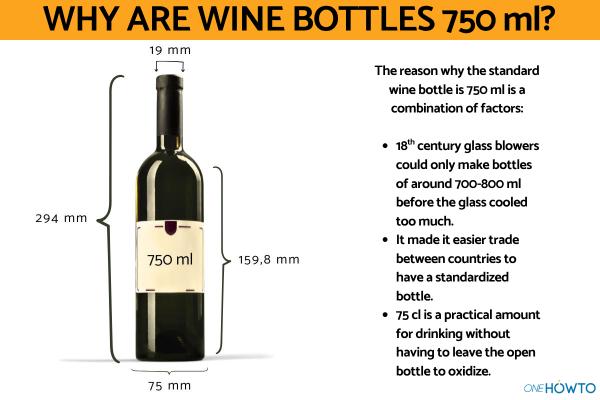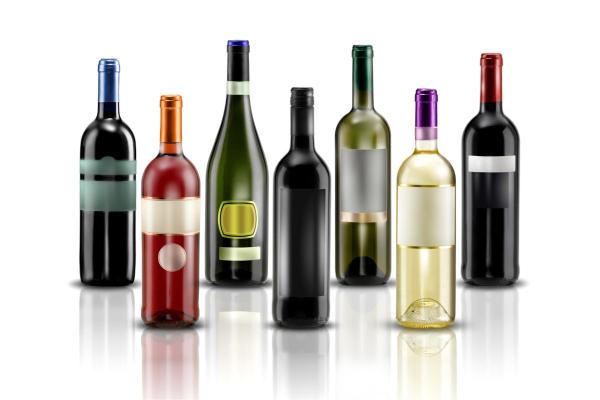Why Are Wine Bottles Exactly 750 ml?


A good bottle of wine can be the perfect gift. Although there are other sizes, the standard bottle of wine is a clean 750 ml. This is too much for some, too little for others and just the perfect amount, depending on occasion and personal taste. The decision to have a standard bottle of wine be 75 cl is not random or arbitrary. It is an amount which has specific historical, practical and commercial reasons that date back centuries. In this new oneHOWTO article, we why are wine bottles exactly 750 ml? As you do find out about the history of wine bottles, you'll discover what it has to do with the glassblower and his puff.
Why wine bottles are exactly 750 ml
The 750 ml capacity may seem strange at first glance. This is because we might rarely drink this much in one sitting, unless we are sharing with others. In countries where milliliters and liters are the standard measurement for beverages, we often see other drinks sold in half liter or liter bottles. Even in the US where fluid ounces are the standard measurement of volume, 750 ml is the standard.
There is no one reason why a wine bottle is exactly 750 ml, but the following reasons explain why this is the case:
- One of the most widely accepted explanations points to 18th-century glassblowers. These artisans made bottles by hand. The average volume a glassblower could mold at once without the glass cooling too much was about 700 to 800 ml. Natural manufacturing capacity limited the size of bottles and 750 ml was established as a working standard.
- Another reason has to do with the trade system between Europe and the United Kingdom. At that time, France exported a lot of wine to England, but the British used the imperial system. The units of measurement did not coincide with the French metric system. To facilitate trade, an equivalence was sought. A standard case of wine contained 12 bottles of 750 ml, which is equivalent to 9 liters or exactly 2.38 imperial gallons. This equivalence made trade easier to calculate and manage.
- From a practical point of view, 750 ml is a perfect amount to share between two or three people. At a dinner party, each person can pour themselves two or three glasses. It's also an appropriate amount to maintain a balance between consumption and preservation. Too much wine will oxidize quickly and too little means guests won't be satiated.
The reason wine bottles have a 750 ml capacity is a combination of the artisanal tradition of glassblowers, the need for a standard for international trade and the practicality of the size for individual or shared consumption.
If you enjoy a drink, but are concerned about putting on weight, check out our article asking is beer or wine more fattening?
History of wine bottles
Wine is one of the oldest alcoholic beverages in the world. Its preservation has been a subject of study for millennia. In ancient times, wines were stored in large clay amphorae, containers that were both very heavy and difficult to transport individually. It wasn't until the 17th century that glass bottles began to be used to store wine. This was especially the case in England, where improved glassmaking techniques allowed for greater commercial use.
Initially, bottles were not standardized in size. They depended on the skill of the glassblower and the customer's needs. With the onset of industrialization and international trade, it became necessary to regulate sizes, capacities and shapes to facilitate the transportation, storage and marketing of wine.
The 19th century saw the arrival of mechanized bottle production. It was at this time 750 ml standard began to establish itself as the most common size of a standard wine bottle. This was both for its practicality and for its ability to preserve the wine well in relation to the oxygen that enters when the bottle is uncorked.
In 1975, the European Economic Community (the precursor to today's European Union) officially established this volume as the standard for wine bottles. It has remained the most common measurement worldwide ever since.
Beverages in the USA often use the imperial system to explain volume, but wine is an exception. In the 1970s, the metric system was used for wines and spirits. This is because these products were more commonly imported and using two different measuring systems would cause a lot of confusion and practical difficulty. This was solidified with the Metric Conversion Act of 1975.

Other sizes of wine bottles
Although the 750 ml bottle is the most common, there are many other sizes used for various occasions. These include being used for celebrations with lots of people to allowing wine to be stored for long periods. The following is a size chart for wine bottles currently in use:
- Demi or half bottle (375 ml): perfect for one person or for a tasting without compromising on a full bottle.
- Magnum (1.5 liters): equivalent to two standard bottles. Very popular at celebrations and also appreciated for wines that age more slowly.
- Jeroboam (3 liters): contains the equivalent of 4 standard bottles. Ideal for parties or large dinners.
- Rehoboam (4.5 liters): most common in champagnes, equivalent to 6 standard bottles.
- Methuselah (6 liters): very visually impressive, often used at large events.
- Salmanazar (9 liters): the equivalent of a whole case of wine in a single bottle.
- Balthazar (12 liters) and Nebuchadnezzar (15 liters): enormous bottles, often reserved for very special celebrations or for collectors. Not a very practical way to pour wine.
In total, there are more than a dozen recognized formats. Many of these bottles have biblical names, especially in the case of sparkling wines. It is unclear why this is the case, but it is likely to do with their use for grand celebrations such as those which involve royalty.
Why use larger wine bottles?
Wines bottled in larger formats, such as magnums or jeroboams, mature better over time. This is because the ratio of wine volume to air in the neck of the bottle is lower, which slows oxidation and allows for more even aging. These formats are most frequently used at celebrations because they offer a much greater visual impact and allow serving more people without having to open multiple bottles.
Now that you know why wine bottles are 750 ml, we encourage you to discover more about what is contained within them by reading our guide to what are Spain's finest wines?
If you want to read similar articles to Why Are Wine Bottles Exactly 750 ml?, we recommend you visit our Food & drink category.





